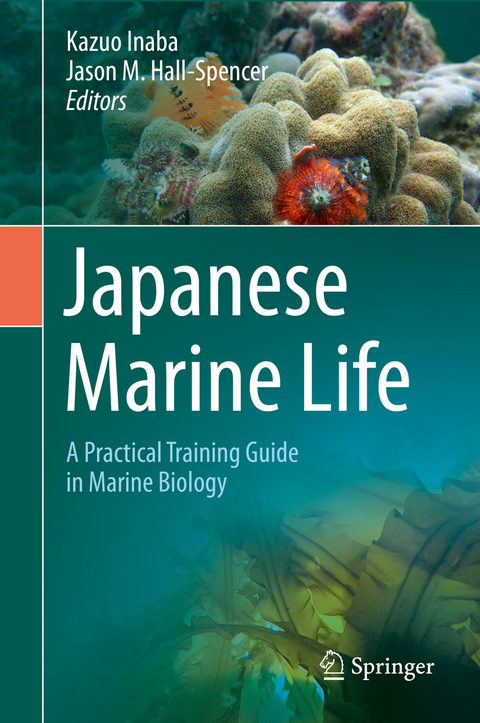
Japanese Marine Life
Springer Verlag, Singapore
978-981-15-1325-1 (ISBN)
Kazuo Inaba holds a PhD from the Graduate School of Science, University of Tokyo (1990). He was an Assistant Professor at Misaki Marine Biological Station, University of Tokyo (1990-1998); Visiting Scientist, Worcester Foundation for Experimental Biology, Massachusetts, USA (1996); Visiting Associate Professor, National Institute for Basic Biology, Japan (2002-2003); Associate Professor, Asamushi Marine Biological Station, Tohoku University (1998-2004); Director (2005-2018), Shimoda Marine Research Center, University of Tsukuba, where he has been a Professor since 2004. He has been President of the Japanese Association of Marine Stations since 2009 and steering member of the World Association of Marine Stations since 2010. He was also a member of the editorial board of the Global Ocean Science Report, UNESCO-IOC (2016-2017). His research interests include cell motility and reproduction of marine invertebrates, fish, algae and other marine organisms; and structure, regulation, diversity and evolution of cilia and flagella. Jason M. Hall-Spencer holds a PhD from Millport Marine Biological Station, University of London (1995). He had postdoctoral positions working all over Europe before becoming a Lecturer in Marine Biology, University of Glasgow in 2000. He moved a Royal Society University Research Fellowship (2003-2008) to the University of Plymouth, where he has been Professor of Marine Biology since 2012. He has been a Research Professor at the University of Tsukuba since 2016. He is a member of the Economics of Ocean Acidification working group (funded by the IAEA Monaco), a UK Government Scientific Advisor on Marine Protected Areas and a member of the ICES working group on deep water ecology. He served on the IPCC ocean acidification working group (2011-12) and the ICES/OSPAR working group on Ocean Acidification 2013-15 and was Chair of the NERC Facility for Scientific Diving Steering Committee 2014-19. He is currently President of the British Phycological Society and is helping write the United Nations World Ocean Assessment II. His research interests include benthic ecology, CO2 seeps, aquaculture, fisheries management and marine conservation.
Chapter 1. Introduction to Marine Biology.- Part I Japanese Marine Flora and Fauna.- Chapter 2. Japanese Marine Life.- Chapter 3. Basic Taxonomy of Marine Organisms.- Chapter 4. Marine Plankton.- Chapter 5. Marine Algae and Plants.- Chapter 6. Marine Animals.- Chapter 7. Distribution of marine species on the marine seashore.- Part II Cell and Developmental Biology.- Chapter 8. Marine organisms and life science.- Chapter 9. Gametes and fertilization.- Chapter 10. Development of Marine Invertebrates.- Chapter 11. Development of marine fish: several procedures for the observation of embryonic development.- Chapter 12. Development of Marine Algae.- Chapter 13. Animal Larvae and Evolution.- Part III Marine Zoology.- Chapter 14. Contribution of marine animals in physiology, endocrinology and ethology.- Chapter 15. Physiology.- Chapter 16. Endocrinology.- Chapter 17. Animal Behavior.- Part IV Marine Ecology.- Chapter 18. Marine Ecology Introduction.- Chapter 19. Marine Ecology – Temperate to Tropical.- Chapter 20. Marine Ecology – Intertidal/Littoral Zone.- Chapter 21. Marine Ecology – Sea Shelf to Deep Sea.- Chapter 22. Marine Ecology – Survey Techniques in Marine Ecology.- Chapter 23. Experimental Design in Marine Ecology.- Part V Marine Environmental Science.- Chapter 24. Marine Environmental Science Introduction.- Chapter 25. Elemental Circulation.- Chapter 26. Human Impact.- Chapter 27. Survey Techniques in Marine Environmental Sciences.- Chapter 28. Experimental Design in Marine Environmental Sciences.- Part VI Selected Topics in Marine Biology.- Chapter 29. Marine Data.- Chapter 30. Biologging.- Chapter 31. Marine Microbes. Chapter 32. Marine Conservation.
| Erscheinungsdatum | 12.05.2020 |
|---|---|
| Zusatzinfo | 133 Illustrations, color; 48 Illustrations, black and white; XVI, 367 p. 181 illus., 133 illus. in color. |
| Verlagsort | Singapore |
| Sprache | englisch |
| Maße | 155 x 235 mm |
| Themenwelt | Naturwissenschaften ► Biologie ► Limnologie / Meeresbiologie |
| Naturwissenschaften ► Biologie ► Ökologie / Naturschutz | |
| Naturwissenschaften ► Geowissenschaften ► Hydrologie / Ozeanografie | |
| ISBN-10 | 981-15-1325-2 / 9811513252 |
| ISBN-13 | 978-981-15-1325-1 / 9789811513251 |
| Zustand | Neuware |
| Haben Sie eine Frage zum Produkt? |
aus dem Bereich


